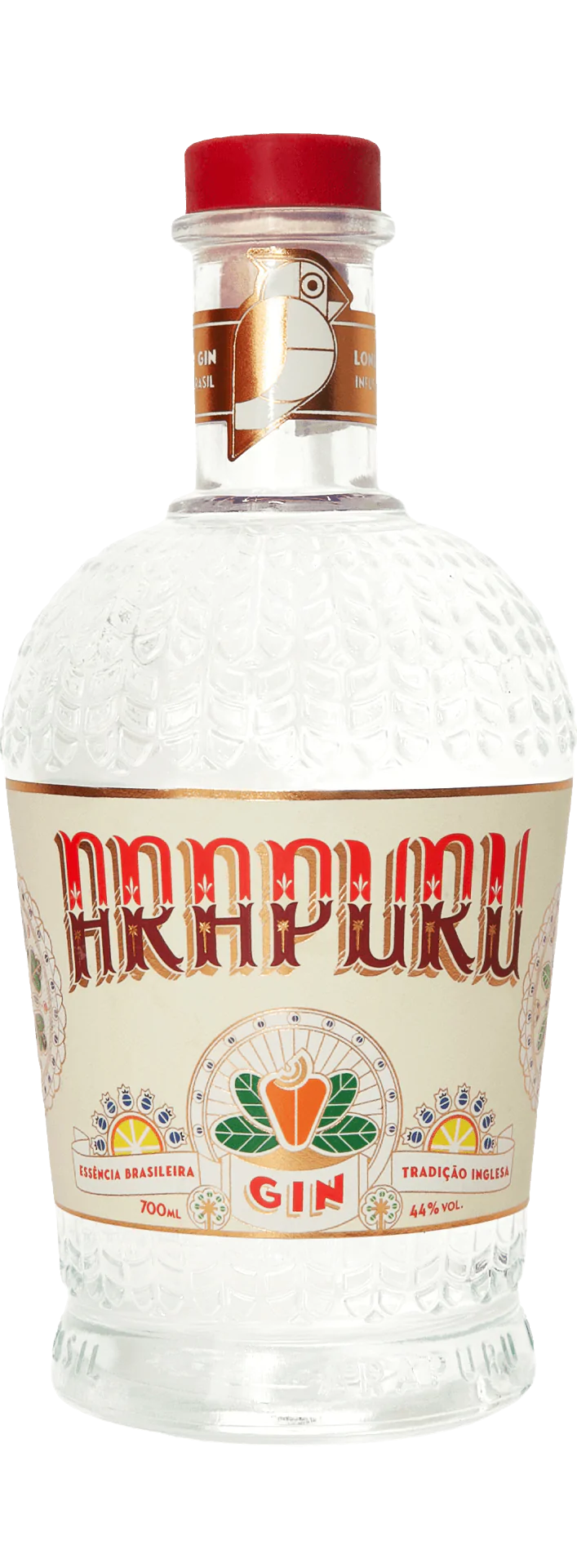
Infused with 12 botanicals from the 5 corners of Brazil! All natural, dehydrated manually, and infused in a high quality artisanal process.
Have you ever tried the cashew fruit? Yes we use it! And it has a prominent role: juicy and astringent, brings out the sweetness and perfume of Brazil.
In addition to the traditional juniper berries, coriander seeds and angelica root, we found unique ingredients to replace the traditional botanicals Rob used in his gins in England.
Imbiriba, the unique “cinnamon” of the Northeast, Puxuri, the “nutmeg” of the Amazon; Pacová, the “cardamom” of the Atlantic Forest; along with Southern Montenegrin Bergamot, Clove Lemon, Aroeira (pink pepper), Laurel and a special Brazilian Hibiscus.”

Arapuru London Dry Gin has a sweet, smooth and captivating aroma. Discreet and unusual, with the presence of juniper and fruity citrusy notes. The taste is vivid. With a juniper front, fruity with citrus and spice notes. The finish is smooth and leaves an interesting warm feeling.
Our London Dry is more than just a gin with exotic botanicals; It is a well-crafted result of an international collaboration. Well balanced, but complex enough. Recommended for fans of contemporary gins.
Our founder Mike moved to São Paulo in 2013 and, as a big culinary fan and arts admirer, he fell in love with the country. When studing Brazil’s history and culture he started appreciating aspects different to the stereotypes know to most tourists. Arapuru is an attempt to capture the essence of Brazil in form of a gin, by infusing unique local botanicals and praising brazilian local cultures and artistic herritage. To start this exciting journey, Mike asked the creator of his favorite gin Martin Miller’s, Rob Dorset, to join forces to create a recipe with ingredients from all five regions of Brazil. Arapuru is distilled in the interior of the state of São Paulo.
We were taught the magic of gin distillation by a true master distiller, Rob Dorsett, creator of award-winning brands like Martin Miller’s, Botanist or Sipsmith. Numerous tests and tastings were carried out between England and Brazil in 2015.
We steep most of our botanicals for 24 hours in heated neutral-grain spirit and the rest is steamed in a copper pot still one shot method.
One of the most prominent figures in the beverage industry, Erik Lorincz, became fascinated by the Brazilian culture and biodiversity since he came for a visit in early 2013. He participated in our creative process, making sure we produce a liquid which highlights our exotic essence in cocktails.
Diageo World Class 2010 winner, Erik came to São Paulo in 2016 to launch Arapuru in the Brazilian market and taught 10 original recipes in an exclusive masterclass to a select group of Brazilian bartenders.
Our juniper berries actually come from Europe as for now we haven’t found a quality supplier in the tropics.
In the indigenous Tupi-Guarani language “caju” means “a nut which grows”. Originally from the Brazilian Northeast, its aroma is intense and striking, you can feel it whenever you open a bottle of Arapuru.
Originally from China, it exudes a pleasant spicy but sweet aroma. When distilled, it adds earthy and slightly bitter taste.
Quite common in the Southeast of Brazil, it is also known as lemon-lime or lemon-tambaqui. Tasty strong citrus fruit whose aromatic, intense green leaves.
Originally from China, it exudes a pleasant spicy but sweet aroma. When distilled, it adds earthy and slightly bitter taste.
Discover some of your favorite cocktails with Arapuru London Dry Gin
This website uses cookies to improve your experience. By continuing to browse this website, you agree to our Privacy Policy.
Arapuru takes you on a journey through pleasures and flavours of Brazil in a single sip. We’ve infused an English tradition of a London Dry Gin with the essence of Brazil, represented by carefully selected botanicals from all five regions of the country.